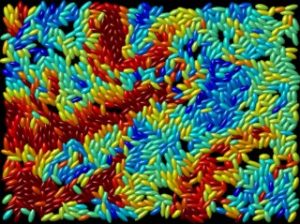As an experimental soft matter physicist with postdoctoral experience in microbial ecology and active matter, I enjoy working at the interface of physics and biology. At present, I am particularly interested in understanding and designing biological, and bioinspired soft active metamaterials. My journey in science thus far, is chronicled below.
Soft Matter Physics:
My doctoral research focused on using dense colloidal suspensions as model systems to gain a microscopic understanding of equilibrium as well as non-equilibrium phenomena commonly observed in atomistic solids and liquids. In particular, using suitable combinations of experimental techniques such as optical and confocal microscopy, rheometry and holographical optical tweezers, I studied various dynamical phenomena associated with grain boundary interface fluctuations in polycrystalline materials as well as glass formation. Click on the images below to visit some of my key papers or take a look at my review articles on grain bounday dynamics and the glass transition, which I have co-authored with my doctoral advisers.
Microbial ecology:
As an HFSP Postdoctoral Fellow in the Gore lab, I studied the influence of migration on the oscillatory population dynamics of laboratory co-cultures of ampicillin-resistant and chloramphenicol-resistant strains of E. coli. In an environment containing both antibiotics, the co-culture exhibits an obligatory cross-protection mutualism in which each strain protects its partner by deactivating one of the antibiotics. Using batch culture daily dilution experiments as well as simulations of a differential equation-based model of antibiotic deactivation, we showed that intermediate levels of migration disturb the period of oscillations and lead to enhanced survival of co-cultures in harsh environments. This work has been published in Nature Communications.
Nonequilibrium self-assembly in active-passive mixtures:
As a PLS fellow at MIT, I have been combining my doctoral interests in soft matter with postdoctoral interests in biophysics. In collaboration with Prof. Nikta Fakhri and her graduate student Junang Li in the MIT Physics of Living Systems group, we have recently shown that motile bacteria induce effective attractions between passive colloids, resulting in a micro phase separated regime that we call dynamic clustering (Phys. Rev. E, 2022). By combining experiments with Brownian dynamics simulations, we showed that Dynamic clustering spans the broad intermediate Peclet number regime between diffusivity-based phase separation at low Peclet numbers, and motility-induced phase separation (MIPS) at high Peclet numbers.
Active metamaterials:
I am currently excited about self-organization in, and design of, metamaterials composed of soft and active building blocks. As part of the team led by Prof. Fakhri and Prof. Jörn Dunkel , I was involved in the discovery of odd elasticity in living chiral crystals of starfish embryos (Nature, 2022). These crystals are examples of living mechanical metamaterials that exhibit fascinating collective dynamics, such as long-lived strain oscillations, even in overdamped conditions. These dynamics are enabled by broken symmetries and the intrinsically nonequilibrium nature of the living building blocks that make up the crystal. My long term aim is to develop the next generation of smart materials by drawing inspiration from these self-organized living metamaterials.


